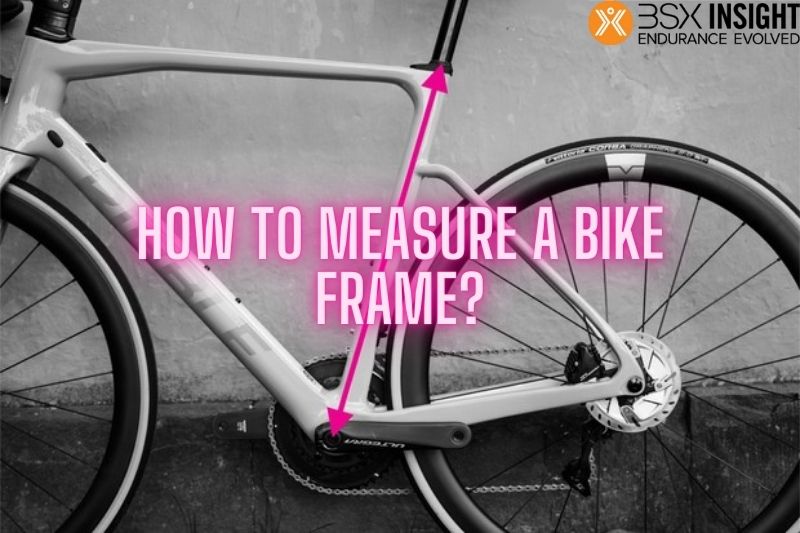Do you have a hard time figuring out how big a bike is because you don’t know where to start? It is very important to learn how to measure a bike frame correctly. It’s helpful if you want to change something about your bike.
A bike that fits you well will be more comfortable to ride and will move faster and more efficiently.
With the help of our detailed guide about How to measure a bike frame? BSXInsight hopes you can feel confident, that the first bike you buy will be the right one for you.
Bike Size Chart
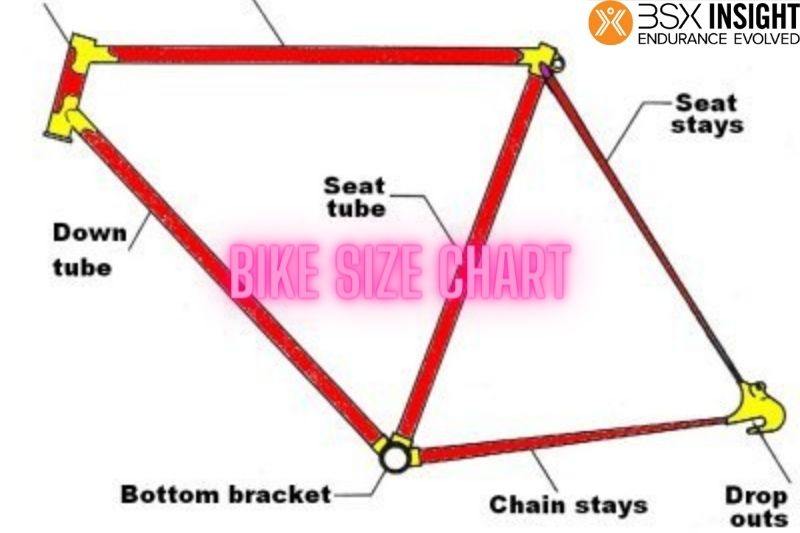
The sizes given are approximations. You alone are responsible for making the ultimate choice.
It is recommended that there be a crotch clearance of at least 2 inches when measured from the standover height.
We got two size charts to provide you, check it out below:
Mountain Bikes
Beach cruisers, comfort, and other hybrid bikes are also sized using this method:
| Height (ft/in) | Height (cm) | Leg inseam (cm) | Leg inseam (inches) | Suggested Frame Size (in) | Suggested Wheel Size |
| 4’10 – 5’3″ | 147-160cm | 62-70 cm | 25 – 28″ | 13 – 14″ | 26″ |
| 5’4 “- 5’7” | 160 – 170cm | 63 – 76 cm | 25 – 30″ | 15 – 16″ | 26″ |
| 5’5″ – 5’9″ | 165 – 175cm | 66 – 78 cm | 26 – 31″ | 16 – 17″ | 27.5″ |
| 5’9″ – 6’0″ | 175 – 183cm | 68 – 81 cm | 27 – 32″ | 17 – 18″ | 27.5″ |
| 6’0″ – 6’3″ | 183 – 190cm | 71 – 83 cm | 28 – 33″ | 18 – 19″ | 29″ |
Road Bikes
Sizing fixies, commuters, and other city bikes is also possible.
| Height (ft/in) | Height (cm) | Suggested Frame Size |
| 4`10”-5`0” | 148-152 cm | 47-48 cm |
| 5`0″-5`3″ | 152-160 cm | 49-50 cm |
| 5`3″-5`6″ | 160-168 cm | 51-52-53 cm |
| 5`6″-5`9″ | 168-175 cm | 54-55 cm |
| 5`9″-6`0″ | 175-183 cm | 56-57-58 cm |
| 6`0″-6`3″ | 183-191 cm | 58-59-60 cm |
What You’ll Need To Measure a Bike Frame?

- A high level of spirit (or you can use the clinometer app and a straight piece of wood)
- Making use of a plumb bob or a leveling rod (or you can improvise with string and a couple of blobs of Blu Tack)
- A tape measure
- A clinometer is a circular instrument used to measure angles (there are free smartphone apps you can download)
How To Measure a Bike Frame For Kid or Adult?
Measuring the Seat Tube
Look for a size label on the bottom of the seat tube first.
The long tube that accepts the bike seat post is called the seat tube. About 3 inches (7.6 cm) up from the chain sprocket, you’ll find a glued-on label with the bike’s frame size.
Not all bicycle frames will have a size label, but if you can find one, use it. To get the right size, you’ll need to measure the seat tube yourself if one isn’t given.
Always keep in mind that either inches or centimeters can be used to describe the size of the frame.
Normal bicycles come in a size range from 48 to 62 centimeters. Bikes at the smaller end of the range are made for shorter people, while those at the larger end (56 cm and up) are made for taller people.
Measure from the center of the gear crank to the top of the seat tube if there isn’t a label.
Start with the end of a measuring tape at the precise middle of the gear crank (the metal post that runs through the center of the chain sprocket on the bike).
Then, climb the tube until the tape reaches the very top. The entire length of the tube must be measured. The frame size is determined by the length of the seat tube.
Remove the seat from the top of the tube and set it aside if doing so will aid in taking accurate measurements.
The seat tube on the average road bike is between 21 and 23 inches long (53–58 cm).
Convert the measurement to centimeters if it’s a road bike.
The standard system of measurement in the United States is based on the imperial system. On the other hand, road bike frame dimensions are invariably given using the metric system. To convert the length in inches to centimeters, simply multiply the total number of inches by 2.54.
Consider for a moment that the length of the seat tube is 22 inches. When multiplied by 2.54, this equates to a height of 55.88 cm for the subject.
Measurements should be done in inches when dealing with a mountain bike frame.
Choosing the Right Size Bike

Measure from the ground to your crotch with your legs spread.
Spread your legs out wide and stand on the ground, barefoot, or in just socks. Split the distance between your feet to about 6-8 inches (15-20 cm).
Measure how many centimeters there are between the floor and your crotch using your measuring tape.
When taking your measurements, be sure to include the crotch area rather than just the crotch of your pants.
Ask a trusted companion or friend to assist you if you feel uncomfortable gauging this distance on your own body without stumbling.
Multiply your inseam length by 0.7 if you’re buying a road bike.
Place the end of a measuring tape exactly in the middle of the gear crank as your starting point (the metal post that runs through the center of the chain sprocket on the bike).
After that, ascend the tube until the tape reaches the very pinnacle of the structure. It is necessary to measure the length of the tube from end to end.
The length of the seat tube is what ultimately decides the size of the frame.
If removing the seat from the top of the tube will help you get more accurate measurements, do that first. Then put the seat somewhere safe.
On the typical road bike, the length of the seat tube is somewhere between 21 and 23 inches (53–58 cm).
Multiply your inseam by 0.66 if you’d like a mountain bike.
The imperial system is the standard measurement system in the United States. Road bike frame dimensions, on the other hand, are always given in metric.
Simply multiply the total number of inches by 2.54 to convert the length in inches to centimeters.
Consider for a moment that the seat tube is 22 inches long. When multiplied by 2.54, this gives the subject a height of 55.88 cm.
When dealing with a mountain bike frame, measurements should be taken in inches.
Purchase a bike with a frame size that matches the number you calculated.
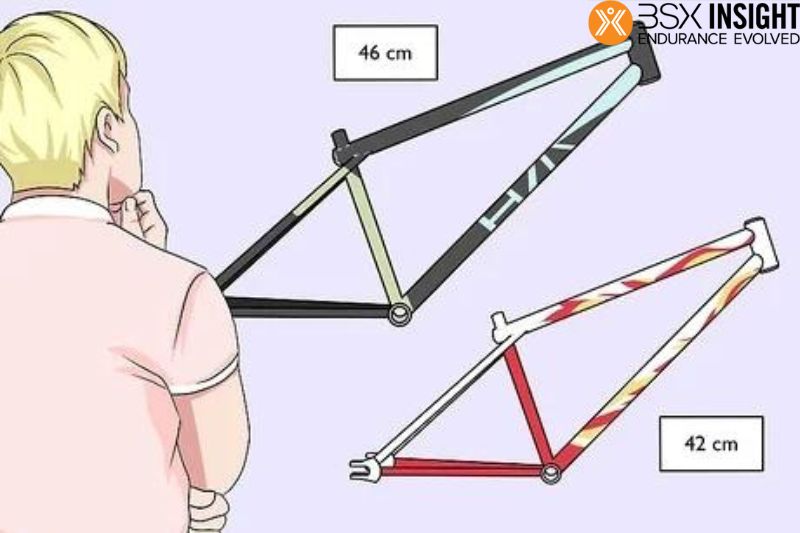
The answer you got from the equation is the size of the bike that will fit your frame. It’s important to test ride a bike before purchasing it to ensure it meets your comfort needs.
Take the bike for a spin around the parking lot, then adjust the seat so that your legs are only slightly bent when you’re pedaling at full extension.
If the seat is too high or the pedals are too far away, you should try a different size bike until you find one that fits you.
When purchasing a used bicycle, if the size is not clearly marked, you can determine the correct size by measuring the seat tube.
Measuring Other Tubes
Find the length of the vertical head tube in millimeters.
The head tube is the part of a bike’s frame that goes from the top of the fork to where the handlebars are attached.
(The “fork” is the hinged piece of metal that connects to the hub of the front wheel.) Use your tape or ruler to mark the point where the handlebars meet the head tube.
Find out how far from the top of the bike to the top of the head tube it is.
If you want an accurate measurement, leave out the height of the post where your handlebars are attached.
A bicycle has three main tubes, but the head tube is the shortest one. Because of this, we usually say the size of the head tube in millimeters and everything else in centimeters.
Compensate for a slanted top tube by measuring the effective top tube.

The top tube can be found between the seat post and the head tube, and it runs roughly perpendicular to the ground (at the base of the handlebars).
The effective top tube length is what needs to be measured in order to get an accurate measurement of a rake-equipped top tube. Get a level and put one end where the top tube meets the head tube.
Make a mental note of where the level crosses the seat tube and maintain a horizontal position (so the air bubble remains in the center of the liquid in which it is suspended).
This will probably be a few inches above the actual point where the top tube meets the seat tube.
If you want to make sure you don’t lose track of where you were when determining the effective top tube length, a small piece of masking tape will do the trick. The location of the measurement can be easily recalled in this way.
The tape should be level with the ground and at the same height as the intersection of the head tube and the top tube. Make sure these two points are even by using a level.
If the top tube is already flat, you can skip this and move on to figuring out the length of the tube.
Slanted top tubes are at their shortest where they connect to the seat tube and their longest where they connect to the head tube.
You’ll find this on the frames of many different types of bikes, but it’s particularly common on road bikes.
Measure the bike frame’s top tube length.
Put the end of a measuring tape on the center of the head tube, where it meets the top tube. Measure along the top tube until you reach the middle of the seat tube. This will give you the length in centimeters.
If your top tube is angled, measure to the effective top tube point you found and marked before. The length of the top tube tells you how far away you are.
The top tube is the tube that sits between your legs when you ride a bike.
What Kind of Bike Do You Ride?
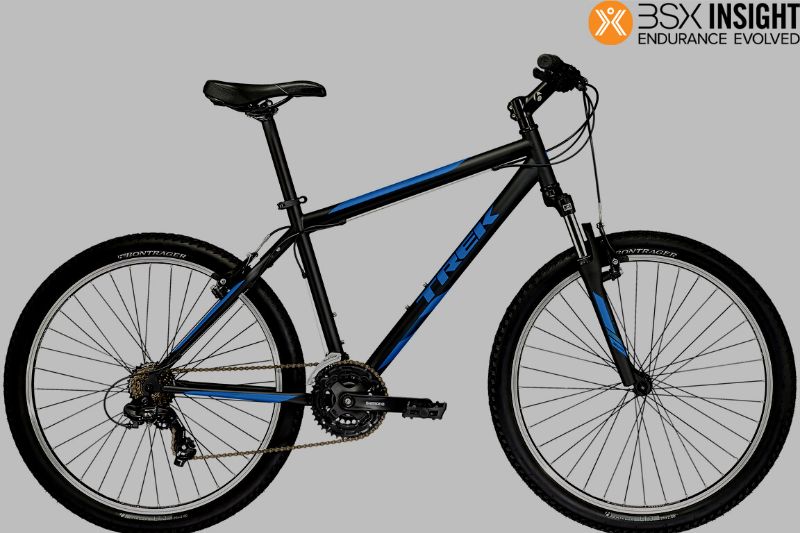
If you’re in the market for a bike but aren’t sure which one to buy and are stuck wondering, “what kind of bike should I get?”
In the midst of so many options, identifying the most common categories of bicycles can be challenging.
There are different kinds of bikes for you to choose from, you can see below:
Road Bikes
The gears on a road bike allow you to pedal more slowly up a hill, making it ideal for racing or commuting. Lightweight and maneuverable, road bikes are popular among commuters and those who frequently ride in traffic.
Fixed-Gear Bikes
The simplest bicycles to ride are fixies, also known as “fixed-gear” or “single-speed” bikes. They can get you where you need to go quickly, don’t weigh you down, and won’t break the bank.
However, there are no gears to assist with climbing hills, and they are not comfortable on uneven surfaces. But if you’re in a hurry and want to see the sights of a city, they’re the way to go.
Hybrid Bikes
The best all-around bike is a hybrid, as they are durable and smooth over uneven terrain. Baskets and shelves are frequently included as well.
They aren’t the swiftest and can weigh a lot, but they’re reliable and strong enough for any task.
If you’re not used to riding over bumps and curbs, a hybrid bike is a great option as a first bike.
Gravel Bikes
The use of gravel bikes, also known as “adventure road bikes,” by commuters is on the rise. A bit bulkier and heavier than a road bike, but still cool because you can load up the racks and panniers with whatever you need to bring along.
Bikes for the city
You’ll see a lot of city bikes, also known as “urban” or “leisure” bikes, in cities where people ride bikes frequently. While they may not be the quickest option, they are reliable and simple to don and remove.
Commonly referred to as “urban bikes,” these bicycles feature racks or baskets to hold your belongings.
Mountain Bikes
In case you frequently go off-roading or ride on a wide variety of surfaces, a mountain bike will be your best friend. Even though they aren’t the quickest, full-suspension vehicles can absorb the majority of the shock from obstacles.
Bike Fitting Guide: How To Choose The Right Bike For You
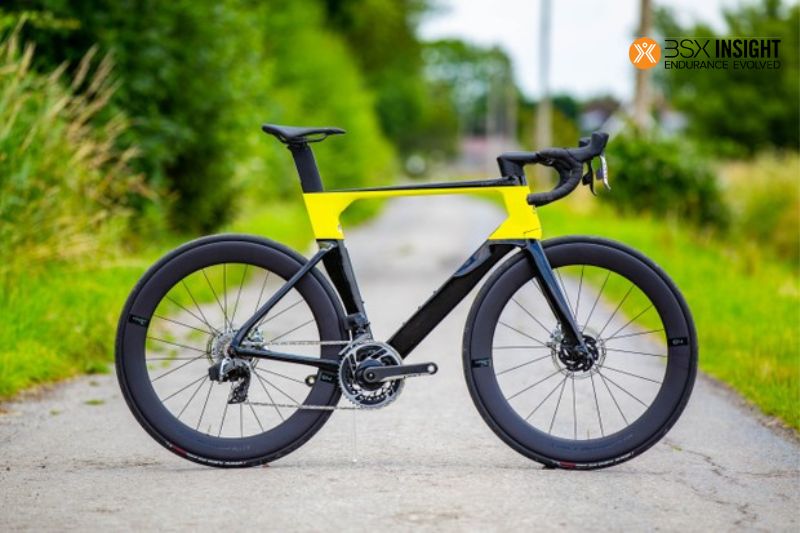
Tip 1: Use The Provided Size Charts
You can get off on the right foot by consulting the bike size charts included in this guide or the manufacturer’s chart for your model.
When bike manufacturers create their own charts, we take notice because they have put in the time and effort to learn everything there is to know about their bikes and the ideal rider size.
Any size chart will give you a rough idea, and you can figure out the specifics later.
Tip 2: What To Do If You Are In Between Bike Sizes
It’s possible that you’ll fall somewhere in between sizes, or that you’ll discover the size that’s recommended for you on the chart doesn’t quite work for you. Both of these scenarios are possible.
Relax, that’s just a recommendation based on the data that was collected. Your long arms and legs will easily be able to accommodate a larger frame if you are of average or above-average height.
Because riders who are shorter than average should opt for the smaller frame size, bikes with excessively large frames can be difficult to handle and uncomfortable to ride.
Tip 3: Useful Checks To Make Sure It’s The Right Size
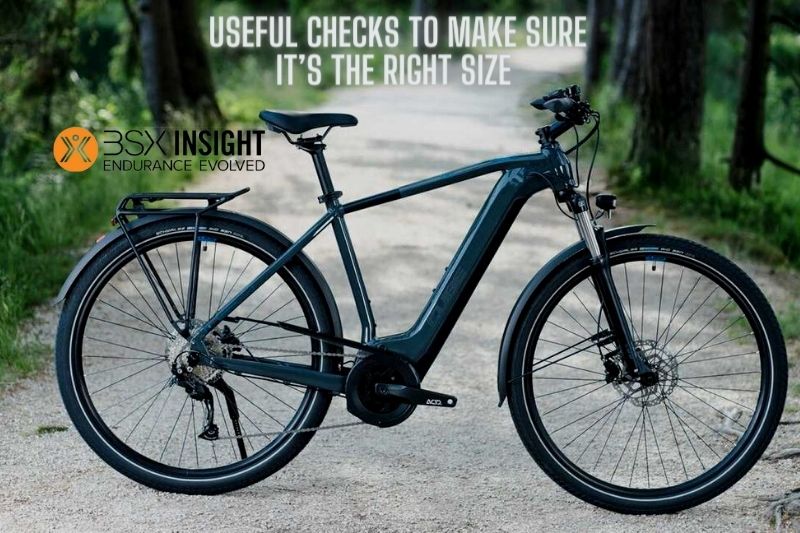
If you have the bicycle with you, you can examine its standover height, leg extension, and reach to determine whether or not it is an appropriate fit for you.
To begin, you will need to cross one leg over the frame of the bike so that you can sit on it. Your crotch should be a couple of inches away from the frame, and the top tube should be positioned so that it is in the middle of your legs.
Because of this, it is much simpler and safer to come to a quick stop on the bike and step off to take a break.
Place your foot on the pedal at the six o’clock position on the bike and see how far your knee bends in that position.
According to what was discussed earlier, the angle ought to be between 15 and 20 degrees. In the event that it falls outside of that range, you have the ability to adjust the height of your seat by either raising or lowering it.
To finish, position your hands on the handlebars in the same manner that you would normally do when riding a bike.
Pay attention to how your body feels and whether or not you spend too much time hunching over.
You can adjust the reach of the bike by shifting the saddle forward or backward, adjusting the height of the stem, or adjusting the angle of the handlebars.
FAQs

What does a 26-inch bike mean?
What is a 26-Inch Bike? Wheels that measure 26 inches in diameter are standard on the ubiquitous 26-inch bike.
The reason why they are so popular is that their size is just right for teenagers and shorter adults. Despite popular belief, the 26-inch number does not indicate the width of the frame, but rather the diameter of the wheel.
What is the average bike size for a woman?
Very petite women may want 26″ wheels, but most will be best served by a 27.5″ or 29″ wheel. These two-wheel sizes are becoming more common on modern mountain bikes, so buying a new bike is likely to have 27.5 or 29-inch wheels.
How do you measure a womans bike?
Use a tape measure to determine the distance between the middle of the pedals, also known as the bottom bracket, and the seat post clamp. This will give you an accurate measurement of the size of the bicycle.
This vertical distance is the frame size, which for mountain bikes is measured in inches, and for road bikes is measured in centimeters.
Conclusion
Now that you know everything there is to know about ways to measure bike frames, you’re free to go about your business. Using a tape measure, like the Amazon Basics Self-Locking Tape Measure, can make life easier for riders.
- Remember that there is a significant difference between the standards used to evaluate a road bike and a mountain bike.
- Consider the space between your feet and your groin. You should do this in bare feet with your legs spread just a little.
- A junior bike can also be measured in a different way.

